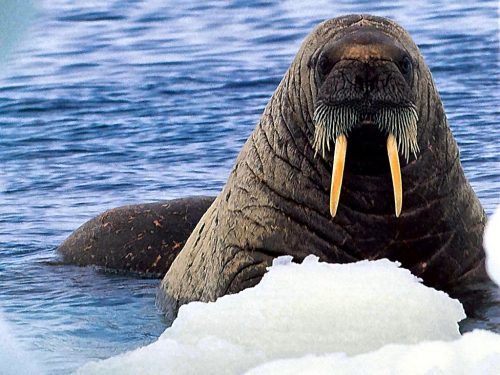Walrus is a large marine mammal and it typically waddles on fore and rear flippers on land. Besides, the animal also propels itself by using rear flippers in water. Walrus looks brown with slight hair on its pinkish body. Large tusks are the most prominent features of walrus which have evolved both in males and females. They are usually found in the western and eastern Atlantic ocean including Greenland, Canada, Russia, and Scandinavia; around Alaska in Chukchi and Bering seas.
Walrus Facts For Kids
Physical Characteristics
- Walrus is 44 – 126 inches (112 – 320 cm) long with the weight measuring around 139 – 2662 lb (63 – 1210 kg).
- Perhaps it is known for its large upper canines that are exposed from its mouths as tusks. Both males and females have tusks but females have longer tusks than those of males.
- It has a flat or ‘pug-nosed’ snout as compared to the snout of other seals. Walrus uses these snouts to locate the prey.
- Walruses have short hair on their body but their neck and flippers do not have hair. When dry these hair are light brown but as it gets wet it becomes darker.
- In order to walk on land, walrus lift their rear flippers from the ground. They seem more like phocids while swimming as they propel by moving their rear flippers.
Read More: Do Female Walruses have Tusks?
Distribution
- Walruses have a circumpolar distribution – from Canadian Arctic to the Kara Sea of Russia. Once they were widespread in the Nova Scotia, Sable Island, Magdalen Islands, and Prince Edward Island in the Gulf of St. Lawrence. But at present they occur in the northern Hudson Bay.
- The Pacific mammal lives in the waters of Chukchi and Bering Seas. They usually travel in packs. Walruses move to the Chukchi sea in summer and Bering sea in winter. Females give birth on ice in between St. Lawrence Islands and Nunivak.
- The Laptev walrus inhabits the Laptev Sea, Siberian Sea, and the Kara Sea.
Read More: What eats Walruses?

Habitat
- Walruses swim in shallow waters of less than 328 ft (100 m). The feeding habits of walrus restrict its habitats. With the arrival of breeding season, females litter on ice floes. They are typically associated with ice floes. However, they will leave the ice floes if they think that ice is now too weak to carry their heavy loads.
- The ice floes must be at least 18 – 20 cm thick to support the large mass of walruses.
- In Alaska in Bristol Bay Round Island thousands of walruses are found side by side. They also breed in large numbers in the Northwest Territories and Coats Island.
Read More: Where do Walruses Live?
Behavior
- Walruses are known to move in small packs but will often rest in large numbers on land or on ice. At times, males will chase down females along with fighting with other males to mate with a female.
- They roar as well as produce in-air whistles. The underwater vocalizations include knocks, bells, taps, and pulses. Walruses might produce these sounds in order to attract females. However, sometimes they will also be vocal when they feel threatened.
- Unlike other pinnipeds, female walruses raise their young on land as well as on sea. The young normally rid the mother’s back especially travelling at sea.
- Males and females use their tusks either in fight with one another or to display a threat. They use their tusks against potential predators like polar bears and killer whales.
- Walruses also use their large protruding tusks in making a hole in the ice. But they do not use it dig for food. They dig with snouts and use their tongue to suck the soft prey from their hard shells.
- Walruses remain in water for as long as half an hour.
Read More: Why do Walruses have Tusks?
Feeding Ecology and Diet
- Young walruses suck their mother’s milk in the first 12 – 18 months. After a span of mother-feeding they will feast on invertebrates as well.
- They are generally known as benthic feeders—eating organisms in the bottom substrate. The fancy eating bivalve mollusks but Pacific walrus is known to consume more than 60 genera of marine organisms.
- These organisms include worms, crustaceans such as crabs and shrimps, corals, crabs and polychaetes. Walruses also feed on sea cucumbers and spotted and ringed seals.
- They have altogether different dietary habits in different regions and seasons. Walruses are able to adapt to the varying habitats.
Reproductive Biology
- Male walruses will not begin breeding until they reach 10 – 11 years of age. They become socially competitive at the age of 15. However, females become mature little earlier than males.
- Walruses have a unique reproductive biology in that they have a gestation period of 15 months or so.
- The female usually gives birth to a single young. They will guard their young in the initial 2 – 3 years. The mother’s milk contains 25 – 32% fat content which is the highest in comparison to the other mammals.
- The maximum lifespan of walrus is 40 years in the wild.
Conservation Status
- Humans had been the greatest threats to these marine mammals. Walruses had been hunted in large numbers in the 1700s and 1800s.
- Atlantic walrus was once present in large numbers on Sable Island and in the Gulf of St. Lawrence but they had disappeared from these sites in the 1700s.
- Walruses are facing several threats from humans such as pollution, habitat destruction, and competition with fisheries. The Pacific walrus has declined in the years gone by but the reason of its decline is not known.

Leave a Reply